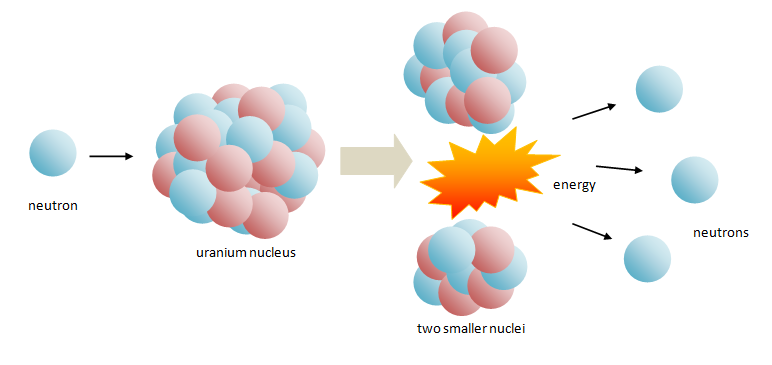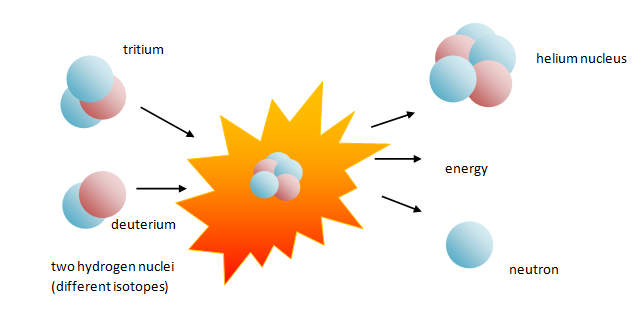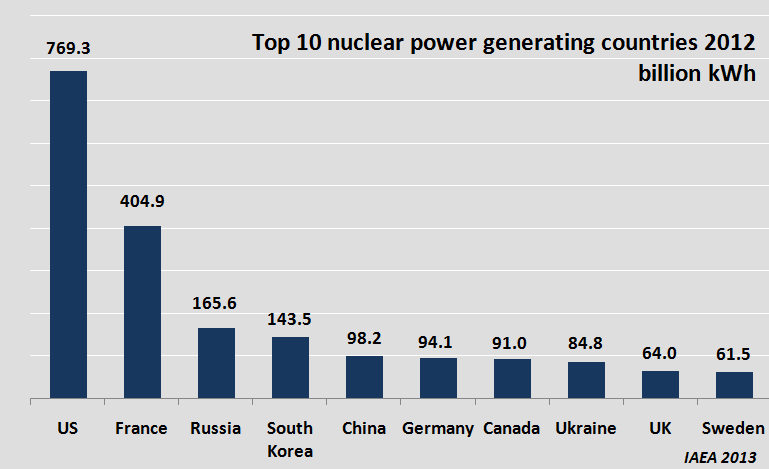Nuclear energy is the energy held in the nucleus of an atom. This is released through nuclear reactions like fission and fusion.
Nuclear power is a term commonly used to describe electricity made from nuclear energy.
However, in science, energy and power are different units of measurement.
A handy way to understand this difference is to think of energy as an amount of resource, like money, and power as the rate of spending it.
For example, a heater with a power rating of 2 kilowatts ‘spends’ 7.2 megajoules of energy in one hour. Another way to say this is that it produces 2 kilowatt-hours of energy in an hour.
According to the US Energy Information Administration, the total electricity generated by nuclear power plants in the US in the year 2012 was 769 billion kilowatt-hours (kWh), or nearly one fifth of the nation’s electricity.
Where does nuclear energy come from?
The particles in the nucleus of an atom – protons and neutrons, collectively called nucleons – are held tightly together with extremely strong bonds. The forces in nuclear bonds are a million times stronger than those of electrons.
Thanks to these bonds, our world is made of a rich variety of elements, ranging from hydrogen – the very lightest, with one proton and up to two neutrons, all the way up to uranium – the heaviest naturally occurring element, with 92 protons and 146 neutrons in its most common isotope.
When a nucleus undergoes transmutation – either by splitting, or fusing, or by gaining or losing nucleons – the total binding energy held in the nuclear bonds changes. Depending on the type of reaction, nuclear energy is either released (exothermic reaction) or consumed (endothermic reaction).
Fission and fusion reactions release large amounts of nuclear energy
Fission and fusion are prime examples of exothermic nuclear reactions – they result in a huge release of energy as some nuclear mass is ultimately converted into heat, according to Einstein’s famous e=mc² equation.
Nuclear Fission
Nuclear fission occurs when a heavy nucleus splits into lighter ones. This is the method used in today’s nuclear power stations to make electricity.
Nuclear Fusion
Nuclear fusion is what happens when two light nuclei combine and form a new, larger, nucleus. This reaction also releases a lot of energy – it is how our Sun produces energy.
However, unlike nuclear fission, a viable technology for making effective use of fusion power does not yet exist. One major challenge is how to get it to yield more energy than it takes to make the reaction happen.
Market Business News has published a detailed explanation on the difference between nuclear fission and nuclear fusion.
Nuclear energy in the world today
Nuclear energy was first used in the Second World War, primarily to make nuclear bombs. But after the war, attention turned to peaceful purposes, notably for power generation.
Today, the world produces as much electricity from nuclear energy, in fission reactors, as it did from all sources combined in 1960.
According to the World Nuclear Association (WNA), civil nuclear power supplies 11.5% of global electricity needs, from 430 reactors in 31 countries. In fact, through grids, the number of countries that use nuclear-generated power is much higher than this.
Nuclear energy is not considered a renewable energy source like wind and solar, because there is a limited supply of uranium to fuel reactors. It is however, often referred to as a sustainable energy source, because there is enough uranium in the world to fuel reactors for at least 100 more years.
In terms of primary energy supply (that is energy in its raw form, before it is converted into anything else like electricity), nuclear energy has grown from 1% to 5% of the world’s total since the 1970s.
Some key facts about countries and nuclear power:
- 16 countries depend on nuclear power for at least a quarter of their electricity.
- France gets around three quarters of its power from nuclear energy.
- Belgium, Bulgaria, Czech Republic, Finland, Hungary, Slovakia, South Korea, Sweden, Switzerland, Slovenia and Ukraine get more than 30% of their electricity from nuclear energy.
- Russia, Spain, the UK and the US get around one fifth of their electricity from nuclear energy.
- Japan is expected to return to relying on nuclear power for 25% of its electricity.
- Although Italy and Denmark have no nuclear power plants, nearly 10% of their power comes from nuclear.
Source: WNA 2013
The top 10 nuclear power generating countries
The top 10 nuclear power generating countries in 2012 were:





